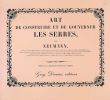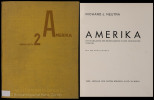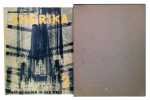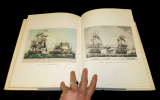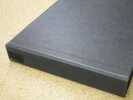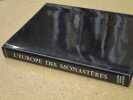-
Type
Any type (2)
Art print (7)
Book (31269)
Disk (1)
Drawings (7)
Engraving (9)
Magazine (130)
Old papers (1)
Photographs (14)
Posters (4)
-
Latest
Last 24h (2)
Last 3 days (18)
Last month (295)
Last week (42)
-
Language
Dutch (1)
English (54)
French (31343)
German (6)
Italian (18)
Japanese (2)
Portuguese (9)
Spanish (11)
-
Century
16th (16)
17th (56)
18th (211)
19th (1571)
20th (9527)
21st (1733)
-
Countries
Belgium (9472)
Brazil (7)
Canada (108)
China (3)
Côte d'Ivoire (63)
Denmark (215)
France (18487)
Germany (1)
Greece (1)
Italy (36)
Switzerland (3051)
-
Syndicate
ALAC (99)
CLAM (42)
CLAQ (94)
CNE (3)
ILAB (10813)
NVVA (1161)
SLACES (1161)
SLAM (8287)
SNCAO (9)
NERVI, Pier Luigi pour la Direction, LLOYD Seton, MULLER Hans Wolfgang, MARTIN Roland.
Reference : 1376
ARCHITECTURE de l'Antiquité, Proche & Myen-Orient, Egypte,Crète & Grèce.
PARIS, Berger-Levrault - 1980 - Grand In-4 ° - Relié - couverture grise - 411 pages - 525 illustrations
Notes d'Architecture.
ECOLE NATIONALE DES PONTS ET CHAUSSEES. 1960 - 1961. In-4. Broché. Bon état, Couv. convenable, Dos satisfaisant, Intérieur frais. 288 pages. Quelques schémas en noir et blanc dans le texte. Quelques tableaux et graphiques en planches dépliantes.. . . . Classification Dewey : 720-Architecture
Classification Dewey : 720-Architecture
Les éléments des projets de construction.
Paris, éd. Dunod, 1969, cinquième édition, gd. in-4, cartonnage toilé grise avec auteur et titre dorés sur pièce de titre percaline rouge éd., 452 pp., 1 gd. planche dépliable "Normes françaises concernant le bâtiment" avec de nb. dessins en noir, de très très nb. dessins en noir, table des matières, bibliographie, index alphabétique des mots-clés, « Ce manuel s'organise autour de quatre grandes parties :- Les fondamentaux : de la conception du projet jusqu'aux techniques constructives, en passant par les éléments et détails de construction ; cette partie intègre également les thématiques communes à de nombreux projets telles que les aménagements extérieurs et les infrastructures liées aux transports. Viennent ensuite trois parties sur les grandes typologies de programmes :- L'habitat : maisons et immeubles.- Les lieux publics : hébergement, enseignement et recherche, lieux de culte, culture et divertissement, sports et loisirs.- Les lieux de travail : administration, bureaux, commerces, industrie, exploitation agricole, santé. Pour les programmes : les concepts de plans d'habitations (maisons individuelles et appartements), les cuisines ; les dispositions générales pour les lieux publics, les habitations pour seniors, les hôtels, les établissements scolaires et les piscines ; la réglementation des lieux de travail, les immeubles de grande hauteur, les containers, les bâtiments pour animaux. Enfin, comme les précédentes, cette 5e édition était conforme aux usages et aux règles en vigueur en France, et transpose systématiquement la problématique dans le contexte français. Véritable bibliothèque d'exemples concrets, d'une variété et d'une richesse inégalées, cet ouvrage constitue la référence tant pour les étudiants en formation que pour les professionnels de l'architecture et du bâtiment. ». RARE Très bon état de la reliure, du papier et de la planche dépliable
Librairie spécialisée en gastronomie , œnologie et tabagie
Recueil élémentaire d'Architecture, contenant plusieurs Etudes des Ordres d'Architecture d'après l'Opinion des Anciens et le Sentiment des Modernes. Différents Entrecolonnements Propres à l'Ordonnance des Façades, Divers Exemples de Décorations Extérieures et Intérieures à l'usage des Monuments Sacrés, Publics et Particuliers. Composé par le Sieur de Neufforge, Architecte. Approuvé le 5 7bre 1757, par Mrs de l'Académie Royale d'Architecture
Paris, Guérinet, circa 1890-1900, 8 tomes en 6 volumes in-folio (dont 2 volumes de supplément) (46,5 x 36 cm), demi-veau gris, dos à 5 nerfs orné de style 18ème.
Réimpression anastatique de l'édition parue au dix-huitième siècle (1757-1780), bien complète des 907 planches montées sur onglets. Bon état général, quelques traces d'usage, étiquettes de bibliothèque collées en haut des volumes. Cet ouvrage n'est constitué que de gravures.
Recueil élémentaire d'Architecture contenant plusieurs études des ordres d'architecture d'après l'opinion des anciens et le sentiment des modernes. Différents entrecolonnement propres à l'ordonnance des façades, divers exemples de décorations extérieures et intérieures à l'usage des Monuments sacrés, publics et particuliers. Composé par le Sieur de Neufforge, Architecte.
[Paris, Guérinet, sans date (vers 1890-1900)], réimpression "anastatique" de l'édition de Paris, 1757-1780, 8 tomes et un supplément reliés en 6 volumes in folio, demi chagrin, dos à nerfs, avec au total 9 feuillets de titre, 2 feuillets de tables et bien complet des 906 planches montées sur onglets ; quelques piqûres éparses ; menus frottis d'usage, une coiffe usée.
"Reproduction rigoureusement exacte et intégrale de l'ouvrage de l'époque... avec... des portes, des croisées, des niches, de la menuiserie, et ornemens à l'usage de batimens sacrés, publics et particuliers... d'hotels et baldaquins, de chapelles, de tombeaux, de chaires à precher, de buffets d'orgue, de lambris et stalles... pavés de marbre, assemblage de charpentes, portiques, berceaux et palissades... décoration façades et appartements... etc... etc..." Les 8 tomes initiaux comportent 600 planches et le supplément (relié en deux volumes) comporte 306 planches (numérotées I à CCCVI). Bon exemplaire, d'une consultation aisée, toutes les planches étant montées sur onglets, de cet important ouvrage pour l'Architecture, la Décoration et le Mobilier du XVIIIe siècle. ...................... Photos sur demande ..........................


Phone number : 04 77 32 63 69
Soirees d'Anvers Nos. 1-12 (all publ.)
, Anvers, Les Editions Ca Ira, 1961-1965 Broche, 8vo. Nos. 1-12 (all publ.). Anvers, Editions a Ira, 1961-1965, Original wrappers; edition limited to 100 copies for the complete set.
Beautiful presented periodical by Paul Neuhuys, with contribs. by Willy Koninckx, Willy Prins, Michel de Ghelderode, Eug.Fromentin, Franz Hellens, Paul Dewalhens, a.o.; special issue on Young Flemish Poets, another on 'Jeune po sie fran aise'; each frontcover illustrated by a drawing. dition limit e 100 exemplaires pour l'ensemble complet. P riodique joliment pr sent par Paul Neuhuys, avec contributions. par Willy Koninckx, Willy Prins, Michel de Ghelderode, Eug.Fromentin, Franz Hellens, Paul Dewalhens, e.a. ; un num ro sp cial sur les Jeunes po tes flamands, un autre sur la Jeune po sie fran aise ; chaque premi re de couverture illustr e par un dessin. Avec contributions de Nic van Bruggen, Tone Brulin, Patrick Conrad, Pierre Dewalhens, Jean Dubief, Sophia Dupray, Max Elskamp, Leon van Essche, Eugene Fromentin, Michel de Ghelderode, Alain Germoz, Gust Gils, Aug. Grisay, Franz Hellens, Jan van der Hoeven, Robert d?Hondschoote, Victor Hugo, Paul Joostens, Paul Justement, Max Kazan, Ben Klein, Willy Koninckx, Marcel van Maele, Mado Millot, Paul Neuhuys, Bob de Nijs, Adriaan Peel, Willy Prins, Raina, Tony Rombouts, Adriaan de Roover, D.A.F. de Sade, Clem Schouwenaars, Werner Spillemaeckers, Dimitri Tchermetiev, Willy Vaerewijck, Rene Vaes, Freddy de Vree, Paul de Vree et autres.
Soirees d'Anvers Nos. III, Fascicule ou Cahier 3
, Anvers, Les Editions Ca Ira, 1961-1965 Broche, 8vo. -Nos. 3. only ;Anvers, Editions a Ira, 1961-1965, Original wrappers; edition limited to 100 copies.
Beautiful presented periodical by Paul Neuhuys, with contribs. by Willy Koninckx, Willy Prins, Michel de Ghelderode, Eug.Fromentin, Franz Hellens, Paul Dewalhens, frontcover illustrated by a drawing. dition limit e 100 exemplaires . P riodique joliment pr sent par Paul Neuhuys, avec contributions. par Willy Koninckx, Willy Prins, Michel de Ghelderode, Eug.Fromentin, Franz Hellens, Paul Dewalhens, e.a. ; un num ro sp cial sur les Jeunes po tes flamands, un autre sur la Jeune po sie fran aise ; chaque premi re de couverture illustr e par un dessin. Avec contributions de Nic van Bruggen, Tone Brulin, Patrick Conrad, Pierre Dewalhens, Jean Dubief, Sophia Dupray, Max Elskamp, Leon van Essche, Eugene Fromentin, Michel de Ghelderode, Alain Germoz, Gust Gils, Aug. Grisay, Franz Hellens, Jan van der Hoeven, Robert d?Hondschoote, Victor Hugo, Paul Joostens, Paul Justement, Max Kazan, Ben Klein, Willy Koninckx, Marcel van Maele, Mado Millot, Paul Neuhuys, Bob de Nijs, Adriaan Peel, Willy Prins, Raina, Tony Rombouts, Adriaan de Roover, D.A.F. de Sade, Clem Schouwenaars, Werner Spillemaeckers, Dimitri Tchermetiev, Willy Vaerewijck, Rene Vaes, Freddy de Vree, Paul de Vree et autres.
Soirees d'Anvers Nos. IV Fascicule ou Cahier 4
, Anvers, Les Editions Ca Ira, 1961-1965 Broche, 8vo. -Nos. 4. only ;Anvers, Editions a Ira, 1961-1965, Original wrappers; edition limited to 100 copies.
Beautiful presented periodical by Paul Neuhuys, with contribs. by Willy Koninckx, Willy Prins, Michel de Ghelderode, Eug.Fromentin, Franz Hellens, Paul Dewalhens, frontcover illustrated by a drawing. dition limit e 100 exemplaires . P riodique joliment pr sent par Paul Neuhuys, avec contributions. par Willy Koninckx, Willy Prins, Michel de Ghelderode, Eug.Fromentin, Franz Hellens, Paul Dewalhens, e.a. ; un num ro sp cial sur les Jeunes po tes flamands, un autre sur la Jeune po sie fran aise ; chaque premi re de couverture illustr e par un dessin. Avec contributions de Nic van Bruggen, Tone Brulin, Patrick Conrad, Pierre Dewalhens, Jean Dubief, Sophia Dupray, Max Elskamp, Leon van Essche, Eugene Fromentin, Michel de Ghelderode, Alain Germoz, Gust Gils, Aug. Grisay, Franz Hellens, Jan van der Hoeven, Robert d?Hondschoote, Victor Hugo, Paul Joostens, Paul Justement, Max Kazan, Ben Klein, Willy Koninckx, Marcel van Maele, Mado Millot, Paul Neuhuys, Bob de Nijs, Adriaan Peel, Willy Prins, Raina, Tony Rombouts, Adriaan de Roover, D.A.F. de Sade, Clem Schouwenaars, Werner Spillemaeckers, Dimitri Tchermetiev, Willy Vaerewijck, Rene Vaes, Freddy de Vree, Paul de Vree et autres.
Prom th e, th tre -Paul Neuhuys.
Bruxelles, La Pierre d'Alun, 1994 couverture originale imprim e de l' diteur. n-8 en feuilles sous couverture rempli e. 16,5x22,5 cm, 78 pages - dition originale.
illustr de 10 gravures hors-texte en relief de Jiri Kolar. 1/519 exemplaires num rot s -86.
Art de construire et de gouverner les serres
Guy Durier, 1980. In Guy Durier, 1980. In-4 carré broché de VII + 104 pages + 21 planches à diverses figures. Petite déchirure sans manque sur le haut de la couverture sinon bon état
Toutes les expéditions sont faites en suivi au-dessus de 25 euros. Expédition quotidienne pour les envois simples, suivis, recommandés ou Colissimo.
Amerika. die Stilbildung des Neuen Bauens in den Vereinigten Staaten.
Wien. Anton Schroll & Co. 1930. 4°. 163 Seiten mit 260 Abbildungen.
Werk aus der Serie: «Neues Bauen in der Welt». Einband staubschmutzig. Auf dem vorderen Vorsatz Besitzereintrag (Stempel) «hubacher u. steiger».
Amerika
Vienne, Neues Bauen in der Welt volume 2, Verlag von Anton Schroll, 1930, 288x230mm, 164pp., broché, jaquette illustrée d’un photomontage, 260 illustrations dans le texte.Conception graphique El Lissitzky. Bel exemplaire.Tupitsyn p.143,145 rep en couleur.(103604)
Phone number : +33 1 48 01 02 37
MET UITZICHT OP ZEE. EEN NIEUW BEGIN VOOR HET KURSAAL VAN OOSTENDE,
, Mercatorfonds, gebonden , HB, 290 x 240 mm, 160 p, 300 illustrations. NL edition nieuwstaat. ISBN 9789061535843.
Sinds het midden van de 19e eeuw drukt het Kursaal zijn stempel op het toeristische en sociale leven van Oostende. De activiteiten die er plaatsvinden hebben in sterke mate bijgedragen tot de aantrekkingskracht van de badstad, en door zijn ligging aan de zeedijk bepaalt het ook in grote mate haar uitzicht. Het huidige kursaal, ontworpen door de Antwerpenaar Leon Stynen, werd in 1953 voltooid. Het is een modernistisch gebouw, opvallend door zijn transparantie en zijn sobere lijnen, dat sinds 1998 als beschermd monument geklasseerd is, maar in de loop der jaren in verval raakte. In 2000 begon de stad Oostende aan een ambitieus restauratieproject dat van het kursaal in 2005 opnieuw het kloppend hart van de Koningin der Badsteden moet maken. Nieuw.
Regenkult-Anlagen in Bogazköy-Hattusa. Eine Deutungsversuch
Tübingen, Ernst Wasmuth 1971 49pp.with ills. + 15 loose folding maps, 27cm., in the series "Deutsches Archäologisches Institut, Abteilung Istanbul. Istanbuler Mitteilungen" Beiheft 5, softcover, G, X71690
Neville Rowley, Pierre Curie, Michel Hochmann, Sara Menato et Gennaro Toscano
Reference : 61168
GIOVANNI BELLINI. MA TRE DE LA RENAISSANCE V NITIENNE.
, Mercatorfonds, 2023 HB, 280 x 240 mm, 192 pages, 100 illustrations en couleurs, FR edition. ISBN 9789462303454.
Le Mus e Jacquemart-Andr met l'honneur en mars 2023 l'oeuvre du peintre Giovanni Bellini, p re de la peinture v nitienne, ayant ouvert la voie cet art de la couleur et du ton qui fit la gloire de la S r nissime. Ce catalogue d'exposition entend d montrer travers environ une cinquantaine d'oeuvres (peintures, dessins, sculptures) comment Giovanni Bellini s'est la fois ouvert de nombreuses influences tout en conservant une part ind niable d'originalit . A la recherche constante de nouveaux mod les imiter - voire d passer - Bellini r ussit en effet conjuguer son influence de la p riode byzantine, de l'art du nord de l'Europe et de la sculpture antique et moderne avec un appel pr gnant du renouveau. R parties selon un ordre th matico-chronologique, les oeuvres de Giovanni Bellini constitueront le fil rouge de l'exposition, tout en tant chaque fois mises en dialogue avec les mod les qui les ont inspir es.
American Naval Broadsides : A Collection of Early Naval Prints (1745-1815)
Clarkson Potter Publishers New York, Philadelphia Maritime Museum Cartonné avec jaquette 1974 In-4 (22 x 28.5 cm), cartonné avec jaquette illustrée en couleurs, 225 pages, texte anglais, une illustration en couleurs en frontispice, 117 illustrations dont 92 en couleurs hors-texte, avant-propos de M. V. Brewington ; jaquette abîmée (coiffes et bords de la jaquette frottés, des marques d'usage aux plats défraîchis), bords des plats et premières pages légèrement jaunis, par ailleurs assez bon état. Livraison a domicile (La Poste) ou en Mondial Relay sur simple demande.
TOWARDS A NEW MUSEUM.
The Monacelli Press ; 1998, in-4 softcover,, 288 pp, illustrations. In english. Couverture en bon état, intérieur en très bon état.
L'Europe des monastères
Zodiaque Zodiaque, 1996. In-folio relié pleine toile noire sous jaquette illustrée et étui. 301 pages, avec plans, croquis, planches couleurs et photos. Exemplaire offert à Monseigneur Raymond Séguy, Evéque d'Autun, lors de son départ en retraite et retour en son aveyron natal, la page de faux titre porte de nombreux ex-donos manuscrits. Très bon état.
Toutes les expéditions sont faites en suivi au-dessus de 25 euros. Expédition quotidienne pour les envois simples, suivis, recommandés ou Colissimo.
An Illustrated Dictionary of Silverware. 2373 entries, relating to British and North American wares, decorative techniques and styles, and leading designers and makers, principally from c.1500 to present.
First paperback edition 2000. London, Thames & Hudson, 1987. 8°. 366 Seiten. Mit 709 s/w Abbildungen. Illustr. Orig.-Pappband.
Europe des monastères. Collection : Les formes de la nuit.
Zodiaque, 1985. 24 x 31, 291 pp., 299 illustrations en couleurs et en N/B, reliure d'édition pleine toile + jaquette, sous étui carton toilé noir, très bon état.
Nombreuses planches en couleurs.
[Collectif De Photographes] - NEWMAN John-Henry , OURSEL Raymond , MOULIN Léo
Reference : 020448
(1996)
ISBN : 2736902289
L'Europe Des Monastères
La Pierre-Qui-vire Zodiaque 1996 Grand In Quarto Sous étui d'éditeur . Jaquette illustée en couleurs . Collection " Les Formes de la Nuit " . Illustrations très nombreuses en couleurs hors-texte sur papier couché et noir et blanc . Calligraphie soignée , paragraphes aérés , grandes marges . Qualité unique de ces ouvrages à offrir en cadeau . Beaux Arts . Architecture . Religion . Spiritualité . - 304 p . , 2 kg 300 gr.
Couverture rigide Comme neuf Jaquette neuve
L'Europe des monastères.
Zodiaque les Formes de la Nuit 1985 Zodiaque, Coll. les Formes de la Nuit, 1985, 291 p., reliure toile éditeur sous jaquette, avec son étui noir uni, environ 31x24 cm. Petits frottements en bordure de jaquette, une trace d'étiquette sur l'étui, bon état pour le reste et intérieur très propre.
Merci de nous contacter à l'avance si vous souhaitez consulter une référence au sein de notre librairie.
Europe des Monast res
, Zodiaque, 1985 toil bleu nuit sous jaquette illustr e et sous tui en carton fin, 291 pages, 32 x 24 cm. Texte en Fran ais. *comme neuf. ISBN 9782736902285.
L'Europe des Monast res
Herzenspein und Nasenschmerz: Karikaturen und Comics im Wilhelm-Busch-Museum Hannover
, Hartung Druck, 2005 Hardcover Leinen gebunden mit (randl diertem) Schutzumschlag, Format 24 x 31 cm, 219 Seiten mit zahlreichen, auch farbigen Illustrationen, ordentlicher Zustand. ISBN 9783921752463.
Hans Joachim Neyer: Herzenspein und Nasenschmerz. Karikaturen und Comics im Wilhelm-Busch-Museum Hannover Deutsches Museum f r Karikatur und kritische Grafik.
LUBA. AUX SOURCES DU ZA RE Edition FR
, Mus e Dapper, Paris, 1993., 1993 Paperback , 253 pages.; c.200 b/w and colour illus., maps, index, biblio.. Text: Francais., 330 x 235 mm ISBN 9782906067226.
150 scultures explorant le royaume de Luba, ses mythes, son histoire, ses peuples, ses artistes et ses arts. Parall lement aux insignes de la royaut , le th me de la femme est omnipr sent dans l'univers symbolique de Luba, o il se trouve exalt et id alis . La porteuse de coupe tr s pr sente ici, participaient aux c r monies d'intronisation des chefs et aux rituels de divination.
 Write to the booksellers
Write to the booksellers


![Soirees d'Anvers Nos. 1-12 (all publ.). NEUHUYS, Paul [ed.]](https://static.livre-rare-book.com/pictures/DCT/43413_thumb.jpg)
![Soirees d'Anvers Nos. III, Fascicule ou Cahier 3. NEUHUYS, Paul [ed.]](https://static.livre-rare-book.com/pictures/DCT/61246_thumb.jpg)
![Soirees d'Anvers Nos. IV Fascicule ou Cahier 4. NEUHUYS, Paul [ed.]](https://static.livre-rare-book.com/pictures/DCT/61245_thumb.jpg)
